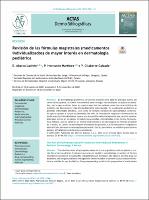Por favor, use este identificador para citar o enlazar este ítem:
https://repositorio.usj.es/handle/123456789/477
Registro completo de metadatos
| Campo DC | Valor | Lengua/Idioma |
|---|---|---|
| dc.contributor.author | Abarca-Lachén, Edgar | - |
| dc.contributor.author | Hernando Martínez, P. | - |
| dc.contributor.author | Gilaberte-Calzada, Yolanda | - |
| dc.date.accessioned | 2021-02-17T08:48:37Z | - |
| dc.date.available | 2021-02-17T08:48:37Z | - |
| dc.date.issued | 2021 | - |
| dc.identifier.citation | Abarca Lachén E, et al. Revisión de las fórmulas magistrales (medicamentos individualizados) de mayor interés en dermatología pediátrica. Actas Dermosifiliogr. 2020. https://doi.org/10.1016/j.ad.2020.11.006 | es_ES |
| dc.identifier.issn | 00017310 | es_ES |
| dc.identifier.uri | https://repositorio.usj.es/handle/123456789/477 | - |
| dc.description | The administration of appropriate doses of active ingredients and excipients is crucial for achieving desired treatment outcomes in pediatric dermatology. A number of factors need to be considered, including the characteristics of the lesion, the patient, and the drug. An additional challenge in pediatric settings is the limited number of commercially available formulations suitable for use in children. Drug compounding, which is the preparation of medications tailored to the needs of individual patients, is a good alternative for pediatric populations for a number of reasons. Using a customized compound, the clinician can prescribe formulations that contain the optimal dose of the active ingredients within acceptable limits and the most suitable vehicle and formulation components. Compounding can also be used to combine several active ingredients in a single medication and even adapt the vehicle to the characteristics of the lesion and the needs of the patient. The pharmaceutical formulations described in this review are based on extensive clinical experience and can be customized to meet individual needs. | es_ES |
| dc.description.abstract | En dermatología pediátrica, la correcta elección de la dosis de principio activo así como del excipiente, se vuelve fundamental para conseguir los resultados terapéuticos desea-dos, por lo que se deben tener en cuenta aspectos tan variados como las características de la lesión, las del paciente, así como las del medicamento seleccionado. En la población pediátrica, se plantean dificultades añadidas tales como la limitada variedad de especialidades comerciales que se ajusten a sus particularidades. Por ello, la formulación magistral o formulación de medicamentos individualizados supone una buena alternativa terapéutica que permite emplear principios activos en los rangos terapéuticos aceptados, vehiculizados en las formas farmacéuticas idóneas, asociar varios en un mismo medicamento e incluso adaptar el vehículo al estado de la lesión, así como a las necesidades intrínsecas del paciente. Las formulaciones recogidas en este artículo, se basan en una amplia experiencia clínica y permiten a los médicos prescriptores adaptar el tratamiento de forma personalizada | es_ES |
| dc.format.extent | 12 p. | es_ES |
| dc.format.mimetype | application/pdf | es_ES |
| dc.language.iso | spa | es_ES |
| dc.publisher | Elsevier Doyma | es_ES |
| dc.rights | Atribución 4.0 Internacional | * |
| dc.rights | Attribution-NonCommercial-NoDerivatives 4.0 Internacional | * |
| dc.rights.uri | http://creativecommons.org/licenses/by-nc-nd/4.0/ | * |
| dc.subject | Formulación magistral | es_ES |
| dc.subject | Dermatología | es_ES |
| dc.subject | Pediatría | es_ES |
| dc.subject | Medicamentos individualizados | es_ES |
| dc.subject | Principio activo | es_ES |
| dc.subject | Vehículo | es_ES |
| dc.subject | Pharmaceutical formulation | es_ES |
| dc.subject | Dermatology | es_ES |
| dc.subject | Pediatrics | es_ES |
| dc.subject | Drug compounding | es_ES |
| dc.subject | Active ingredients | es_ES |
| dc.subject | Vehicles | es_ES |
| dc.title | Revisión de las fórmulas magistrales (medicamentos individualizados) de mayor interés en dermatología pediátrica | es_ES |
| dc.title.alternative | The Most Useful Pharmaceutical Formulations (Individualized Medications) in Pediatric Dermatology: A Review | es_ES |
| dc.type | journal article | es_ES |
| dc.subject.unesco | Pediatría | es_ES |
| dc.identifier.doi | 10.1016/j.ad.2020.11.006 | es_ES |
| dc.rights.accessRights | open access | es_ES |
| Aparece en las colecciones: | Artículos de revistas | |
Ficheros en este ítem:
| Fichero | Descripción | Tamaño | Formato | |
|---|---|---|---|---|
| Revisión de las fórmulas magistrales (medicamentos individualizados) de mayor interés en dermatología pediátrica.pdf | 727,62 kB | Adobe PDF |  Visualizar/Abrir |
Este ítem está sujeto a una licencia Creative Commons Licencia Creative Commons

